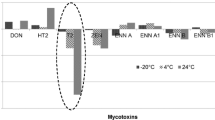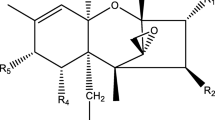Abstract
A total of 237 commercially available samples of cereal-based foods including bread and related products, noodles, breakfast cereals, baby and infant foods, rice and other foods were randomly collected in southwest Germany during the first six months of 1998. The trichothecenes deoxynivalenol (DON), 3-and 15-acetyl-deoxynivalenol (3-,15-ADON), nivalenol (NIV), fusarenon-X (FUS-X), T-2 toxin (T-2) and HT-2 toxin (HT-2) were determined by gaschromatography/mass spectrometry following clean-up by a two stage solid-phase extraction. Detection limits ranged between 2 and 12 μg/kg. Based on all samples, the incidence of DON, HT-2, T-2, 3-ADON,15-ADON, and NIV was at 71, 18, 4, 4, 4 and 2%, respectively; the average contents in positive samples were at 103, 16, 14, 17, 24 and 109 μg/kg,respectively. Fus-X was not detected in any sample. A lower (P < 0.05) DON content was found in baby and infant foods as well as in cookies and cakes compared to bread. Overall, based on the incidence and level of all six toxins, the degree of contamination was lowest in baby and infant foods. Foods produced from either white or whole grain flour did not differ (P > 0.05) with regard to the incidence and level of DON. In foods produced from cereals of organic production both the incidence and median content of DON was lower compared to conventional production. Zearalenone, α- and β-zearalenol were determined by high performance liquid chromatography in 20 selected samples, mostly baby and infant foods. These toxins were not present in excess of the detection limit in any sample.
Similar content being viewed by others
References
Gareis M, Bauer J, Enders J, Gedek B. Contamination of cereals and other feed with Fusarium mycotoxins in European countries. In: Chelkowski J, ed. Fusarium, Mycotoxins, Taxonomy and Pathogenicity. Amsterdam: Elsevier, 1989; 441–472.
Placinta CM, D'Mello JPF, Macdonald AMC. A review of worldwide contamination of cereal grains and animal feed with Fusarium mycotoxins. Anim Feed Sci Technol 1999; 78, 21–37.
Müller H-M, Reimann J, Schumacher U, Schwadorf K. Fusarium toxins in wheat harvested during six years in an area of southwest Germany. Natural Toxins 1997a; 5: 24–30.
Müller H-M, Reimann J, Schumacher U, Schwadorf K. Natural occurrence of Fusarium toxins in barley harvested during five years in an area of southwest Germany. Mycopathologia 1997b; 137: 185–192.
Müller H-M, Reimann J, Schumacher U, Schwadorf K. Natural occurrence of Fusarium toxins in oats harvested during five years in an area of southwest Germany. Food Addit Contam 1998; 15: 801–806.
Yoshizawa T, Hosokawa H. Natural occurrence of deoxynivalenol and nivalenol, trichothecene mycotoxins, in commercial foods. J Food Hyg Soc Jap 1983; 24: 413–415.
Blaas W, Kellert M, Steinmeyer S, Tiebach R, Weber R. Untersuchung von Cerealien auf Deoxynivalenol und Nivalenol im unteren μg/kg Bereich. Z Lebensm Unters Forsch 1984; 179: 104–108.
Brumley WC, Trucksess MW, Adler SH, Cohen CK, White KD, Sphon JA. Negative ion chemical ionization mass spectrometry of deoxynivalenol (DON): Application to identification of DON in grains and snack foods after quantitation/isolation by thin layer chromatography. J Agric Food Chem 1985; 33: 326–330.
Tanaka T, Hasegawa A, Matsuki Y, Ueno Y. A survey of the occurrence of nivalenol, deoxynivalenol and zearalenone in foodstuffs and health foods in Japan. Food Addit Contam 1985; 2: 259–265.
Nowicki TW, Gaba DG, Dexter JE, Matsuo RR, Clear RM. Retention of the Fusarium mycotoxin deoxynivalenol in wheat during processing and cooking of spaghetti and noodles. J Cereal Sci 1988; 8: 189–202.
Abouzied MM, Azcona JI, Braselton WE, Pestka JJ. Immunochemical assessment of mycotoxins in 1989 grain foods: Evidence for deoxynivalenol (vomitoxin) contamination. Appl Environ Microbiol 1991; 57: 672–677.
Trucksess MW, Flood MT, Page SW. Thin layer chromatographic determination of deoxynivalenol in processed grain foods. J Assoc Off Anal Chem 1986; 69: 35–36.
Trucksess MW, Ready DE, Pender MK, Ligmond CA, Wood GE, Page SW. Determination and survey of deoxynivalenol in white flour, whole wheat flour and bran. J Assoc Off Anal Chem Int 1996; 79: 883–887.
Pacin AM, Resnik SL, Neira MS, Molto G. Martinez E. Natural occurence of deoxynivalenol in wheat, wheat flour and bakery products in Argentina. Food Addit Contam 1997; 14: 327–331.
Neira MS, Pacin AM, Martinez EJ, Molto G, Resnik SL. The effects of bakery processing on natural deoxynivalenol contamination. Internat J Food Microbiol 1997; 37: 21–25.
Usleber E, Märtlbauer E. A limited survey of cereal foods from the German market for Fusarium toxins (deoxynivalenol, zearalenone, fumonisins). Arch Lebensmittelhyg 1998; 49: 42–45.
Kamimura H. Removal of mycotoxins during food processing. In: Natori S, Hasimoto K, Ueno Y, eds. Mycotoxins and Phycotoxins '88. Amsterdam: Elsevier, 1989: 169–176.
Ramakrishna, Y, Bhat RV, Vasanthi S. Natural occurrence of mycotoxins in staple foods in India. J Agric Food Chem 1990; 38: 1857–1859.
Petterson H. Trichothecene occurrence in European cereals - A review. Proc of the International Seminar on Fusarium-Mycotoxins, Taxonomy and Pathogenicity. May 9–13, Italy, Martina Franca, 1995.
Valente Soares LM, Furlani RPZ. Survey of mycotoxins in wheat and wheat products sold in health food stores of the city of Campinas, state of São Paulo. Rev Microbiol São Paulo 1996; 27: 41–45.
Schollenberger M, Lauber U, Terry Jara H, Suchy S, Drochner W, Müller H-M. Determination of eight trichothecenes by gas chromatography mass-spectrometry after sample clean-up by a two-stage solid phase extraction. J Chromatogr A 1998; 815: 123–132.
Langseth W, Elen O. Differences between barley, oats and wheat in the occurrence of deoxynivalenol and other trichothecenes in Norwegian grain. J. Phytopathol 1996; 144: 113–118.
Langseth W, Elen O. The occurrence of deoxynivalenol in Norwegian cereals - Differences between years and districts. Acta Agric Scand, Sect B, Soil Plant Sci 1997; 47: 176–184.
Hietaniemi V, Kumpulainen J. Contents of Fusarium toxins in Finnish and imported grains and feeds. Food Addit Contam 1991; 8: 171–182.
Young JC, Fulcher RG, Hayhoe JH, Scott PM, Dexter JE. Effect of milling and baking on deoxynivalenol (vomitoxin) content of Eastern Canadian wheats. J Agric Food Chem 1984; 32: 659–664.
Tanaka T, Hasegawa A, Yamamoto S, Matsuki Y, Ueno Y. Residues of Fusarium mycotoxins, nivalenol, deoxynivalenol and zearalenone, in wheat and processed food after milling and baking. J Food Hyg Soc Jap 1986; 27: 653–654.
Marx H, Gedek B, Kollarczik B. Vergleichende Untersuchungen zum mykotoxikologischen Status von ökologisch und konventionell angebautem Getreide. Z Lebensm Unters Forsch 1995; 201: 83–86.
Berleth M, Backes F, Krämer J. Schimmelpilzspektrum und Mykotoxine (Deoxynivalenol und Ochratoxin A) in Getreideproben aus ökologischem und integriertem Anbau. Agrobiol Res 1998; 51: 369–376.
FAO. Worldwide regulations for mycotoxins 1995 - a compendium. Food and Nutrition Paper 64. Food and Agriculture Organisation, Rome, 1997.
Müller HM, Reimann J, Schumacher U, Schwadorf K. Gemeinsames Vorkommen von Fusarientoxinen in Getreide. In: Märtlbauer E, Usleber E, eds. Proceedings of the 19th Mycotoxin-Workshop, Munich, 1997:10–14.
Wannemacher RW Jr, Bunner DL, Neufeld HA. Toxicity of trichothecenes and other related mycotoxins in laboratory animals. In: Smith JE, Henderson RS, eds. Mycotoxins and Animal Foods. Boca Raton: CRC Press, 1991: 499–552.
Author information
Authors and Affiliations
Rights and permissions
About this article
Cite this article
Schollenberger, M., Suchy, S., Jara, H.T. et al. A survey of Fusarium toxins in cereal-based foods marketed in an area of southwest Germany. Mycopathologia 147, 49–57 (1999). https://doi.org/10.1023/A:1007088502400
Issue Date:
DOI: https://doi.org/10.1023/A:1007088502400




